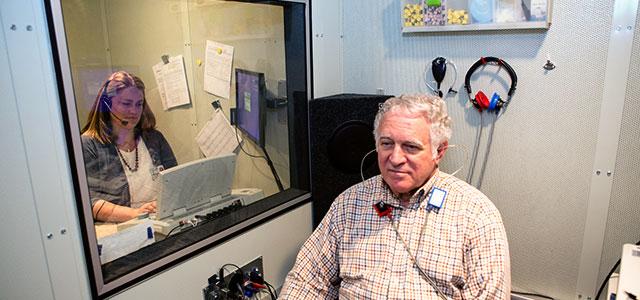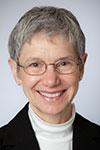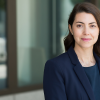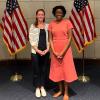
Research Audiologist Jennifer Henderson Sabes screens a patient for hearing loss at the UCSF Audiology Clinic (photos by Elisabeth Fall).
Wallhagen Makes the Case to Routinely Screen Older Adults for Hearing Loss
Margaret Wallhagen, director of the John A. Hartford Center of Gerontological Nursing Excellence at UC San Francisco School of Nursing, is outspoken about her frustration at the most recent guidelines on hearing screening from the US Preventive Services Task Force, an influential independent panel of preventative medicine experts. The task force’s recommendations, while not regulatory, tend to be closely followed by primary care providers nationwide. Its current take on routine adult hearing screening is that there isn’t enough evidence to make a recommendation.
 Margaret Wallhagen “Unfortunately, what that did was reconfirm what’s already been going on – which is no screening. That’s the last thing we needed,” says Wallhagen, who has been researching the effects of hearing loss on seniors for years. “Hearing loss is associated with isolation, depression and many other negative health outcomes; screening should be standard practice.”
Margaret Wallhagen “Unfortunately, what that did was reconfirm what’s already been going on – which is no screening. That’s the last thing we needed,” says Wallhagen, who has been researching the effects of hearing loss on seniors for years. “Hearing loss is associated with isolation, depression and many other negative health outcomes; screening should be standard practice.”
Faced with a growing population of older Americans, indisputable data that hearing loss is associated with aging, provocative new research linking hearing loss to cognitive decline, and decades of studies documenting the negative impacts of impaired hearing, Wallhagen and other experts are determined to push for public policy that aligns hearing screening with other routine testing, such as for blood pressure, cholesterol and diabetes. These experts stress that only with better screening will the estimated thousands of people with untreated hearing loss stand a chance of getting help.
“Absolutely, there is momentum building for better screening,” says Anna Gilmore Hall, executive director of the Hearing Loss Association of America, an education and advocacy group, of which Wallhagen is a board member. “I think we’re at a tipping point; baby boomers are aging into their hearing loss. Not only are we going to see more awareness around hearing loss, but we’re going to see more action to address it.”
A Growing, Often Overlooked Problem
According to the National Institute on Deafness and Other Communication Disorders (NIDCD), about 17 percent of adults in the US have hearing loss, with the condition closely correlating with age. About 18 percent of adults 45-64 years old have hearing loss; this increases to 30 percent of those 65-74 years old, and to 47 percent of adults 75 or older, the institute reports.
These numbers are considered a low estimate, because many people with decreased hearing go undiagnosed for a variety of reasons. Some chalk their hearing problems up to a normal part of aging, not worth mentioning. Others aren’t aware their hearing is changing, especially with gradual loss. Many others downplay it because they are embarrassed. Family members can also be hesitant to intervene, not wanting to embarrass or upset a loved one.
“The problem is partially how many people don’t admit it,” says medical sociologist William Strawbridge, an adjunct professor at the School’s Institute for Health and Aging and Wallhagen’s husband and research partner on many hearing studies.
Still others can’t afford, or balk at, the cost of hearings aids – the standard way of helping those with hearing loss. Most insurance providers, including Medicare, don’t regularly cover this cost.
Another aspect of the problem is that many providers don’t look for or address hearing loss in their elderly patients because they don’t consider it a major issue or aren’t familiar with the ways it can be helped.
Suffering through – rather than seeking help – is unfortunately common, Wallhagen says. “Hearing loss is often overlooked.… It’s a silent and individual condition in most cases; medically, it’s absolutely an invisible problem.”
Taking the Issue to the Public Policy Arena
Wallhagen was among the experts pressing for more attention to hearing loss at a recent Institute of Medicine (IOM) workshop on Hearing Loss and Healthy Aging, held in Washington, DC. Topics included the lack of knowledge about hearing loss among providers, recent research findings on the effects of loss, and the costs of care.
“From a payment perspective, there are many barriers to accessing help,” says Wallhagen, who covered cost issues in her IOM presentation. For hearing aids to be effective, they must be fitted and regularly adjusted by professionals. Patient education is key. Sometimes other devices are advised, such as personal amplifiers or telecoils, which enhance hearing aids.
There is also promising new research linking hearing loss to cognitive decline – and this work is getting lots of attention from policy and health experts. Led largely by Frank Lin, an assistant professor at the Johns Hopkins University School of Medicine, who co-chaired the IOM workshop, the research hasn’t yet established why the conditions are linked. Lin is closely examining three avenues: a shared physiological pathway causing both dementia and hearing loss; cognitive overload, which means the stresses and strains of trying to decipher sounds could be overwhelming the brain; and the social isolation of hearing loss, with isolation being a known risk factor for cognitive decline.
They all play a role, he says. “The evidence is incredibly clear that these aren’t mutually exclusive. It’s a combination of all the above. What’s key moving forward is: What can we do about it?” Lin says.
This current line of research builds on years of work documenting the negative effects of hearing loss on mental health, self-esteem and relationships, including key published studies by Wallhagen and Strawbridge as they tracked a cohort of Alameda County residents for years, looking at rates of hearing loss, detection and impacts.
“Our early research found that having hearing loss is associated with a number of negative outcomes, including poorer physical and mental health as well as social functioning,” Strawbridge says. He also notes that the research suggests that only about 20 percent of primary care practitioners screen for hearing loss.
Lin calls Wallhagen a pathfinder and inspiration. “She’s been one of the most consistent and surest voices out there about the impacts of hearing loss on adults; she’s been waving the flag for decades.”
New Research for Cost-Effective Answers
One of the challenges in changing adult preventative care to add routine hearing screening is that the prevention task force uses cost-benefit analysis for its recommendations – calling for screening only when its costs, whether financial or as a personal burden, are outweighed by the benefits of treatment.
While there are decades of research – including Wallhagen’s work – documenting the toll of hearing loss on a person’s quality of life, there’s less data translating this to monetary costs, largely because many of the impacts are “soft,” Wallhagen says. “I acknowledge that the kind of data they were looking for is one of the big gaps. How do you put an economic value on hearing birds singing?”
Determining the economic impacts of impaired hearing on workers is easier, because you can calculate lost wages or productivity. After people retire, however, it’s harder to measure the value of hearing in dollars – but no less important to try, Wallhagen says. “If you want to keep people healthy and engaged when they’re older and retired, you’ve got to help them hear – if they want to volunteer or attend board meetings or travel.”
In their latest research, Wallhagen and Strawbridge have launched a study testing three relatively simple clinical approaches to hearing loss, partially in the hopes that such an intervention could prove cost-effective.
Funded by the NIDCD, the study will follow 504 patients at six Bay Area primary care clinics who have been identified as having possible hearing loss, and compare the outcomes of three interventions: screening only, screening with an educational brochure and screening with an educational brochure and a brief training by a knowledgeable professional. The study will follow patients for eight months and track and compare the costs of clinical time and the use and benefits of hearing health services by those screened.
Wallhagen and Strawbridge theorize that the third approach, a brochure along with patient education, will result in more people being successfully outfitted with hearing aids or other devices – and more likely to use communication strategies that improve hearing, even without aids.
And they hope that if this is true, the costs of the staff time doing the screening and training will be reasonable for the benefits gained. The study’s initial funding is for three years, with results about two years off.
“It’s such a shame to be shut out when you want to be engaged,” says Wallhagen. “We have to get better at helping all of us stay engaged.”



